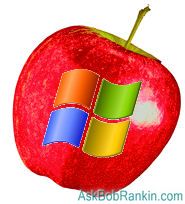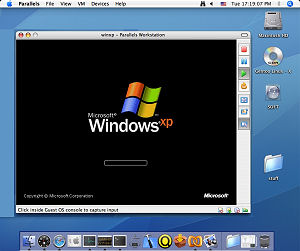So what's a computer user who wants the best of both worlds to do? Buy two systems? Sure, that's an option. But if you are limited in regards to financial resources and space, or if you just want to be edgy, you can run BOTH Windows and Mac on one computer. The most effective way to do this is to use the various tools available that allow you to run Windows and Windows-compatible applications on a Mac. NOTE: This article is the second in a two-part series. See also Switching From Windows to Mac. With Parallels Desktop for Mac, you can run any version of Windows, from Windows 3.1 to Windows Vista, on your Mac OS desktop, right alongside your Mac apps. You can even copy and paste items between your Mac desktop and your Windows desktop. The new Coherence mode makes your Windows desktop disappear so that Windows apps look like any other Mac application. Their icons even show up in the Dock and the Option-Tab application switcher. And by the way, you can also run Linux, OS/2, Solaris or FreeBSD with Parallels. Installation is easy -- download the free trial version, doubleclick the install file and follow the prompts. After install, you can start the Parallels Desktop by double-clicking the orange Parallels icon in Finder->Applications. After activation, you can setup the "Guest OS" that you want to run on your Mac, by clicking on the "Install OS" button in the Parallels Desktop window. There is a recommended easy-to-follow express install to setup Windows XP or Windows Vista. Insert the Windows XP or Vista installation disc when prompted, and voila! You are now installing Windows onto your Mac. Parallels fools the guest OS into thinking that it's running on real a real computer, but as I mentioned before, it's actually a virtual PC created in your Mac's memory. Most people find the performance of Windows running under Parallels quite good, but there are a few limitations. Games that require DirectX will not run, for example. Other emulator programs similar to Parallels include VMware Fusion and iEmulator. Microsoft also has an emulator called Virtual PC for Mac. This program currently does not run on Macs with Intel processors, but is a good option for those with older PowerPC Macs. Once again, to install Windows with Boot Camp, it's BYOS -- Bring Your Own Software. You must have a full version of the Windows OS that you want boot, and also a Mac with an Intel processor. You will need a CD burner and blank CD; the pre-install steps walk you through downloading necessary drivers that Windows needs to recognize Mac-specific hardware. The Boot Camp Assistant walks you through this task in an interactive, user-friendly way which otherwise would be kind of daunting if you had to go it alone. The Boot Camp Assistant also creates a new hard drive partition for your Windows OS, so you don't have to worry about the Windows OS messing with your Mac files. After the Assistant finishes its tasks, you are guided through additional prompts to finalize the install. For more help and info on Boot Camp, see this article describing how to boot Windows XP on an Intel-based Mac. After installation, when you want to select which OS to start, you simply hold down the "Option" key until you see a picture of two disks. One will say "Windows" and the other will say "Macintosh HD". Click the arrow beneath each disk to select the one you want. You can also choose which system you want as the default OS by going into System Preferences when you are in Mac mode. Remember as always, before engaging in the installation of any product that mucks about with hard drive partitions or operating systems: back-up, Back-up, BACK-UP! Save any important files to your favorite backup media in case of any oopsies! Okay... so you don't need the entire Windows OS experience. If you just want to run some Windows-based apps or games on your Mac, without the hassle of installing an operating system, there's a solution for you as well. CrossOver Mac is a program that will let you run Windows applications on your Mac, as opposed to an entire Windows OS. The best thing about CrossOver is that you don't need a copy of the Windows operating system, which can lower the cost of entry. CrossOver is a favorite among Mac users who want or need to run PC-based games or Windows business applications on the Mac OS. In case you missed it earlier, this article is the second in a two-part series. See also Switching From Windows to Mac if you want some practical help about leaving Windows behind entirely. One would think from all the media buzz, that computer users fall into two distinct categories: right-brain dominant, artsy, latte-slurping Macintosh users and left-brain dominant, corporate drone, numbers-crunching Windows users. The reality is that there's both a sterotypical Mac user and a Windows user in all of us. We want the secure multi-media friendly environment of the Mac, and we want the ability to run the myriad of software out there that's mostly created for Windows. Depending on the task at hand, sometimes a Mac is just right for the job, and sometimes a Windows application is what you need.
One would think from all the media buzz, that computer users fall into two distinct categories: right-brain dominant, artsy, latte-slurping Macintosh users and left-brain dominant, corporate drone, numbers-crunching Windows users. The reality is that there's both a sterotypical Mac user and a Windows user in all of us. We want the secure multi-media friendly environment of the Mac, and we want the ability to run the myriad of software out there that's mostly created for Windows. Depending on the task at hand, sometimes a Mac is just right for the job, and sometimes a Windows application is what you need.A Virtual World
 One way to get Windows running on a Mac desktop is to install an emulator or virtualizer program. A virtualizer creates a virtual PC in your computer's memory, then boots up a different operating system on the virtual hardware. Parallels Desktop is a program that will do this. The caveats are: it will only run on Apple's newer Intel-based line of computers and only on Mac OS X 10.4.6 or higher. Also, you do need a full version of the Windows system you want to install as the secondary OS -- upgrade versions will not work.
One way to get Windows running on a Mac desktop is to install an emulator or virtualizer program. A virtualizer creates a virtual PC in your computer's memory, then boots up a different operating system on the virtual hardware. Parallels Desktop is a program that will do this. The caveats are: it will only run on Apple's newer Intel-based line of computers and only on Mac OS X 10.4.6 or higher. Also, you do need a full version of the Windows system you want to install as the secondary OS -- upgrade versions will not work.Off to Boot Camp!
 Geeks rejoiced when Apple released a product named Boot Camp in 2006. Boot Camp allowed for the installation of both Mac and Windows on the same machine. A full install of both systems, mind you, not an emulation or a virtual PC environment. When your computer boots up, you are given the option of which OS you want to run. This is known as dual booting. If you've tried Parallels and had problems, Boot Camp may be better way to get Windows up and running on your Mac. The downside is that you have to reboot the machine in order to switch from Windows to Mac, or vice versa.
Geeks rejoiced when Apple released a product named Boot Camp in 2006. Boot Camp allowed for the installation of both Mac and Windows on the same machine. A full install of both systems, mind you, not an emulation or a virtual PC environment. When your computer boots up, you are given the option of which OS you want to run. This is known as dual booting. If you've tried Parallels and had problems, Boot Camp may be better way to get Windows up and running on your Mac. The downside is that you have to reboot the machine in order to switch from Windows to Mac, or vice versa.Just The Apps, Ma'am
Sunday, April 6, 2008
How to Run Windows Programs on Your Mac Desktop
Subscribe to:
Post Comments (Atom)


No comments:
Post a Comment